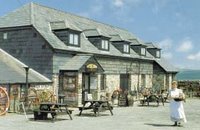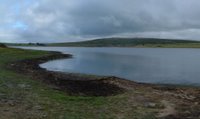Day 5: Cornwall (T.H.White, Daphne du Maurier, Rumer Godden)
Today starts with a longer drive as we head south-west to Cornwall. Although I have no Cornish blood, part of my heart belongs in this wild, beautiful county that has never quite counted itself as part of England. During my childhood we had relatives there and spent many summer holidays in Cornwall, first in Padstow on the north coast, and later at St.Just, a few miles north of Land's End, the far south-west tip of Britain.
Cornwall has many literary connections and we will start our tour at another Arthurian site, Tintagel Castle. Like the Round Table in Winchester, the connection is more fantasy than reality, for Tintagel Castle was built by Richard, earl of Cornwall (brother of King Edward I) in the thirteenth century. The castle is spectacularly located on a rocky promontary climbing steeply from the sea, in two sections linked by a short causeway. The Cornish coast is, quite simply, stunning, with a succession of rocky coves and sandy bays. Add a ruined castle and it is close to perfection. Many authors have written versions of the story of King Arthur, but I have a special fondness for the most tongue in cheek one: The Sword in the Stone by T.H.White, a humorous telling of Arthur's boyhood. For a more substantial retelling of the Arthurian legends, I like Roger Lancelyn Green's King Arthur and His Knights of the Round Table.
The castle is spectacularly located on a rocky promontary climbing steeply from the sea, in two sections linked by a short causeway. The Cornish coast is, quite simply, stunning, with a succession of rocky coves and sandy bays. Add a ruined castle and it is close to perfection. Many authors have written versions of the story of King Arthur, but I have a special fondness for the most tongue in cheek one: The Sword in the Stone by T.H.White, a humorous telling of Arthur's boyhood. For a more substantial retelling of the Arthurian legends, I like Roger Lancelyn Green's King Arthur and His Knights of the Round Table.
From Tintagel on the north coast we are going to drive south, skirting Bodmin Moor to the west. I am not a particular fan of Daphne du Maurier, but have read and enjoyed two or three of her books in the dim and distant past.One of these was Jamaica Inn, so we really ought to stop off at the Inn - maybe for a late lunch? Built in the eighteenth century as a coaching inn, it is still a pub and hotel. After our break we can set off across the wilds of Bodmin Moor. Only a mile or two south of Jamaica Inn is Dozmary Pool, yet another Arthurian site. Legend has it that this is the lake into which Arthur's sword Excalibur was thrown as he lay dying.
After our break we can set off across the wilds of Bodmin Moor. Only a mile or two south of Jamaica Inn is Dozmary Pool, yet another Arthurian site. Legend has it that this is the lake into which Arthur's sword Excalibur was thrown as he lay dying.
 A little further south-west and we reach the area that was once the centre of the Cornish china clay industry. The literary connection here is one of my favourite authors, Rumer Godden. One of her lesser known
A little further south-west and we reach the area that was once the centre of the Cornish china clay industry. The literary connection here is one of my favourite authors, Rumer Godden. One of her lesser known  books (sadly out of print) is set in this area. China Court is the story of a house built on the proceeds of Cornish clay and the family that lived there. I found it a few years ago by chance in a hotel library - I love it when hotels have an eclectic selection of books available for guests to read! We only stayed there a couple of nights, but it was long enough for me to finish the book. I've never seen it since and have forgotten the details of the plot, but I remember enjoying it thoroughly. The clay pits were not pretty, but in their day were vitally important to the Cor
books (sadly out of print) is set in this area. China Court is the story of a house built on the proceeds of Cornish clay and the family that lived there. I found it a few years ago by chance in a hotel library - I love it when hotels have an eclectic selection of books available for guests to read! We only stayed there a couple of nights, but it was long enough for me to finish the book. I've never seen it since and have forgotten the details of the plot, but I remember enjoying it thoroughly. The clay pits were not pretty, but in their day were vitally important to the Cor nish economy. Today the area is being developed for leisure, with cycle and walking paths, and in one disused china clay pit the Eden Project. Built just a few years ago as a project for the Millenium, the centrepiece is two giant conservatories, or "biomes" - one with a tropical climate and one temperate - which together with the outdoor plants make up a spectacular botanic garden. I've yet to visit the Eden Project and I'm tempted to add an extra day to the tour just to fit this in - despite the lack of literary connections.
nish economy. Today the area is being developed for leisure, with cycle and walking paths, and in one disused china clay pit the Eden Project. Built just a few years ago as a project for the Millenium, the centrepiece is two giant conservatories, or "biomes" - one with a tropical climate and one temperate - which together with the outdoor plants make up a spectacular botanic garden. I've yet to visit the Eden Project and I'm tempted to add an extra day to the tour just to fit this in - despite the lack of literary connections.
Today's tour is a busy one, but somewhere we need to fit in afternoon tea of Cornish splits (similar to scones, but with a lighter texture) and clotted cream. Tomorrow we will be going in search of the perfect Cornish pasty.
Wednesday, March 01, 2006
A Literary Tour: Day 5
Labels:
literary tour





